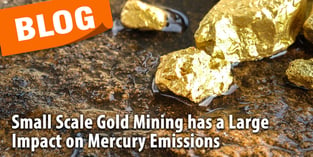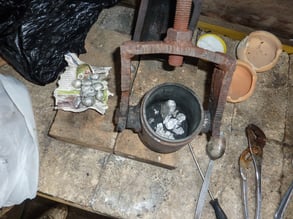 Artisanal and small-scale gold mining (ASGM) is defined by the Minamata Convention on Mercury as ‘gold mining conducted by individual miners or small enterprises with limited capital investment and production’. This type of mining often uses liquid mercury which forms an amalgam with the gold ore in the soil. The very small particles of gold are dissolved into the mercury to form a dark grey clump. To release the gold from the amalgam, the alloy is melted over a flame, driving the gaseous mercury vapor into the air and leaving behind the extracted gold. It is estimated that ASGM produces up to 20% of the world’s gold and 35% of all mercury pollution into the environment. Gold mining using mercury is detrimental to the health of workers, their environment, and their communities but there are economic and social considerations that limit the implementation of mercury free mining technologies.
Artisanal and small-scale gold mining (ASGM) is defined by the Minamata Convention on Mercury as ‘gold mining conducted by individual miners or small enterprises with limited capital investment and production’. This type of mining often uses liquid mercury which forms an amalgam with the gold ore in the soil. The very small particles of gold are dissolved into the mercury to form a dark grey clump. To release the gold from the amalgam, the alloy is melted over a flame, driving the gaseous mercury vapor into the air and leaving behind the extracted gold. It is estimated that ASGM produces up to 20% of the world’s gold and 35% of all mercury pollution into the environment. Gold mining using mercury is detrimental to the health of workers, their environment, and their communities but there are economic and social considerations that limit the implementation of mercury free mining technologies.
ASGM employs 15 million people in 70 countries, often in remote areas with limited economic opportunity. 4-5 million gold miners, or about 28% of the workforce, are women and children. Since mercury-gold amalgamation requires little equipment or infrastructure to recover high yields, it is often preferred over mercury free alternatives. A lack of utility services like electricity and water supplies at these rural campsites limit alternatives that require power or plumbed water sources. Liquid mercury is also readily available and sold by middlemen at the mining sites. Materials like borax or liquified petroleum gas used in mercury free techniques are much harder to access requiring time and travel to acquire and are more expensive than mercury. Some proposed mercury free methods are more time consuming, which is a drawback for miners who are paid by the gram, not by the hour. In order to reduce or eliminate mercury in gold mining, the alternatives need to be equivalent (or better) in terms of cost, time, and simplicity and consider the limited infrastructure of the mining sites.
 For the alternative technologies to be socially and economically viable, the ASGM sector needs to be formally regulated by governments. Under the Minamata Convention, development of a National Action Plan (NAP) is an obligation for each party that determines ASGM in its territory is more than insignificant. One of the strategic measures to be implemented by each NAP is the formalization or regulation of the ASGM sector. By encouraging ASGM participants to join mining corporative groups and associations, there can be a framework to facilitate knowledge, supply chains, financial services, and monitor regulations. Using Zimbabwe’s NAP as an example, it recommends mining associations be ‘under the direction of the Zimbabwe Miners Federation, Ministry of Mines and Mining Development, and RBZ [Reserve Bank of Zimbabwe] using at least 1% of the [yearly] fiscal budget.’ There is no single mercury free technology that is suitable for all countries. By formalizing the industry and adopting policy that considers the economic and social constraints involved, gold has a chance to go mercury free.
For the alternative technologies to be socially and economically viable, the ASGM sector needs to be formally regulated by governments. Under the Minamata Convention, development of a National Action Plan (NAP) is an obligation for each party that determines ASGM in its territory is more than insignificant. One of the strategic measures to be implemented by each NAP is the formalization or regulation of the ASGM sector. By encouraging ASGM participants to join mining corporative groups and associations, there can be a framework to facilitate knowledge, supply chains, financial services, and monitor regulations. Using Zimbabwe’s NAP as an example, it recommends mining associations be ‘under the direction of the Zimbabwe Miners Federation, Ministry of Mines and Mining Development, and RBZ [Reserve Bank of Zimbabwe] using at least 1% of the [yearly] fiscal budget.’ There is no single mercury free technology that is suitable for all countries. By formalizing the industry and adopting policy that considers the economic and social constraints involved, gold has a chance to go mercury free.
For more information on Teledyne Leeman Labs Mercury Analyzers or ICP-OES Systems, click the button below
https://www.youtube.com/watch?v=5JuNWu-b44c

